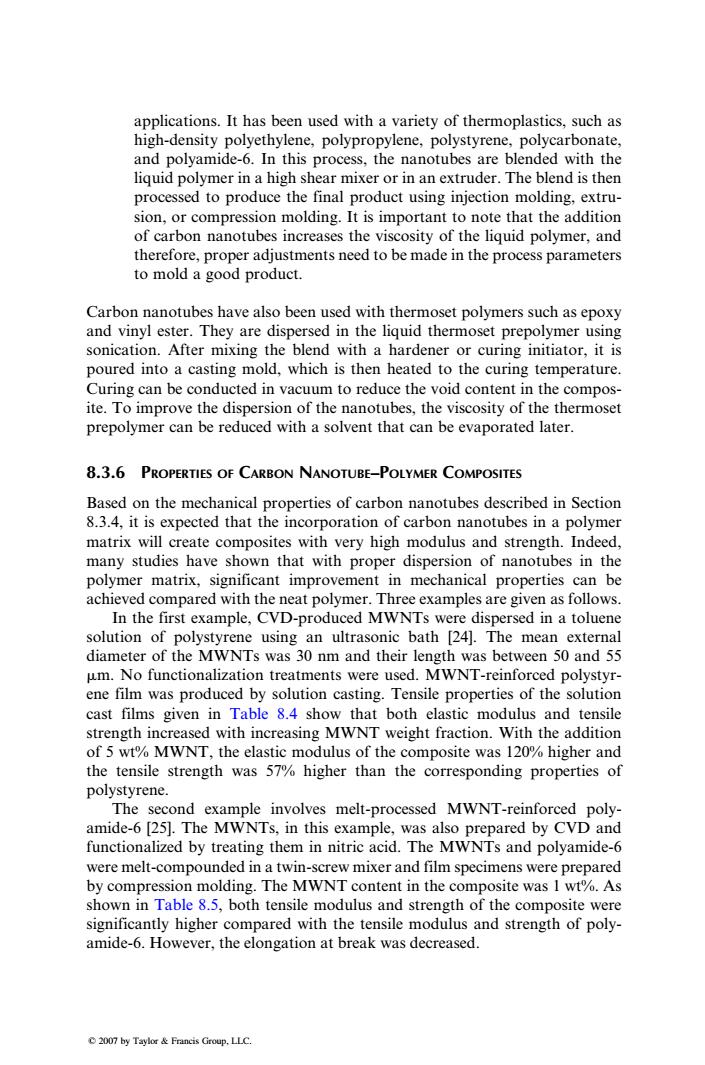正在加载图片...

applications.It has been used with a variety of thermoplastics,such as high-density polyethylene,polypropylene,polystyrene,polycarbonate, and polyamide-6.In this process,the nanotubes are blended with the liquid polymer in a high shear mixer or in an extruder.The blend is then processed to produce the final product using injection molding,extru- sion,or compression molding.It is important to note that the addition of carbon nanotubes increases the viscosity of the liquid polymer,and therefore,proper adjustments need to be made in the process parameters to mold a good product. Carbon nanotubes have also been used with thermoset polymers such as epoxy and vinyl ester.They are dispersed in the liquid thermoset prepolymer using sonication.After mixing the blend with a hardener or curing initiator,it is poured into a casting mold,which is then heated to the curing temperature. Curing can be conducted in vacuum to reduce the void content in the compos- ite.To improve the dispersion of the nanotubes,the viscosity of the thermoset prepolymer can be reduced with a solvent that can be evaporated later. 8.3.6 PROPERTIES OF CARBON NANOTUBE-POLYMER COMPOSITES Based on the mechanical properties of carbon nanotubes described in Section 8.3.4,it is expected that the incorporation of carbon nanotubes in a polymer matrix will create composites with very high modulus and strength.Indeed, many studies have shown that with proper dispersion of nanotubes in the polymer matrix,significant improvement in mechanical properties can be achieved compared with the neat polymer.Three examples are given as follows. In the first example,CVD-produced MWNTs were dispersed in a toluene solution of polystyrene using an ultrasonic bath [24].The mean external diameter of the MWNTs was 30 nm and their length was between 50 and 55 um.No functionalization treatments were used.MWNT-reinforced polystyr- ene film was produced by solution casting.Tensile properties of the solution cast films given in Table 8.4 show that both elastic modulus and tensile strength increased with increasing MWNT weight fraction.With the addition of 5 wt%MWNT,the elastic modulus of the composite was 120%higher and the tensile strength was 57%higher than the corresponding properties of polystyrene. The second example involves melt-processed MWNT-reinforced poly- amide-6 [25].The MWNTs,in this example,was also prepared by CVD and functionalized by treating them in nitric acid.The MWNTs and polyamide-6 were melt-compounded in a twin-screw mixer and film specimens were prepared by compression molding.The MWNT content in the composite was I wt%.As shown in Table 8.5,both tensile modulus and strength of the composite were significantly higher compared with the tensile modulus and strength of poly- amide-6.However,the elongation at break was decreased. 2007 by Taylor Francis Group,LLC.applications. It has been used with a variety of thermoplastics, such as high-density polyethylene, polypropylene, polystyrene, polycarbonate, and polyamide-6. In this process, the nanotubes are blended with the liquid polymer in a high shear mixer or in an extruder. The blend is then processed to produce the final product using injection molding, extrusion, or compression molding. It is important to note that the addition of carbon nanotubes increases the viscosity of the liquid polymer, and therefore, proper adjustments need to be made in the process parameters to mold a good product. Carbon nanotubes have also been used with thermoset polymers such as epoxy and vinyl ester. They are dispersed in the liquid thermoset prepolymer using sonication. After mixing the blend with a hardener or curing initiator, it is poured into a casting mold, which is then heated to the curing temperature. Curing can be conducted in vacuum to reduce the void content in the composite. To improve the dispersion of the nanotubes, the viscosity of the thermoset prepolymer can be reduced with a solvent that can be evaporated later. 8.3.6 PROPERTIES OF CARBON NANOTUBE–POLYMER COMPOSITES Based on the mechanical properties of carbon nanotubes described in Section 8.3.4, it is expected that the incorporation of carbon nanotubes in a polymer matrix will create composites with very high modulus and strength. Indeed, many studies have shown that with proper dispersion of nanotubes in the polymer matrix, significant improvement in mechanical properties can be achieved compared with the neat polymer. Three examples are given as follows. In the first example, CVD-produced MWNTs were dispersed in a toluene solution of polystyrene using an ultrasonic bath [24]. The mean external diameter of the MWNTs was 30 nm and their length was between 50 and 55 mm. No functionalization treatments were used. MWNT-reinforced polystyrene film was produced by solution casting. Tensile properties of the solution cast films given in Table 8.4 show that both elastic modulus and tensile strength increased with increasing MWNT weight fraction. With the addition of 5 wt% MWNT, the elastic modulus of the composite was 120% higher and the tensile strength was 57% higher than the corresponding properties of polystyrene. The second example involves melt-processed MWNT-reinforced polyamide-6 [25]. The MWNTs, in this example, was also prepared by CVD and functionalized by treating them in nitric acid. The MWNTs and polyamide-6 were melt-compounded in a twin-screw mixer and film specimens were prepared by compression molding. The MWNT content in the composite was 1 wt%. As shown in Table 8.5, both tensile modulus and strength of the composite were significantly higher compared with the tensile modulus and strength of polyamide-6. However, the elongation at break was decreased. 2007 by Taylor & Francis Group, LLC